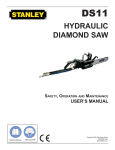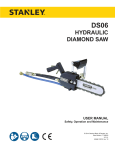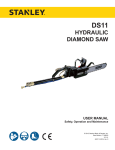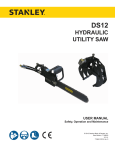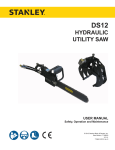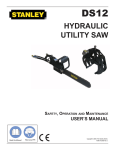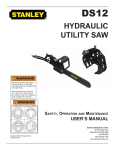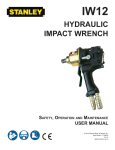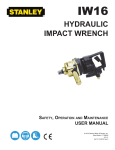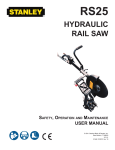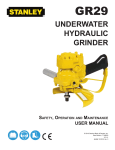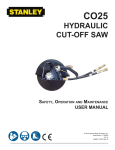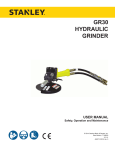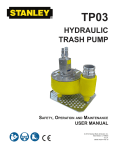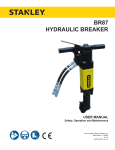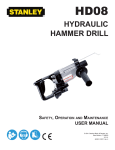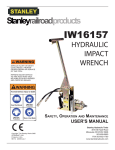Download HYDRAULIC DIAMOND SAW
Transcript
DS11 HYDRAULIC DIAMOND SAW Safety, Operation and Maintenance USER MANUAL © 2010 Stanley Black & Decker, Inc. New Britain, CT 06053 U.S.A. 62211 12/2010 Ver. 4 DECLARATION OF CONFORMITY DECLARATION OF CONFORMITY ÜBEREINSTIMMUNGS-ERkLARUNG DECLARATION DE CONFORMITE CEE DECLARACION DE CONFORMIDAD DICHIARAZIONE DI CONFORMITA Hydraulic Tools ______________________________________________________________________ I, the undersigned: Ich, der Unterzeichnende: Je soussigné: El abajo firmante: lo sottoscritto: Weisbeck, Andy Surname and First names/Familiennname und Vornamen/Nom et prénom/Nombre y apellido/Cognome e nome hereby declare that the equipment specified hereunder: bestätige hiermit, daß erklaren Produkt genannten Werk oder Gerät: déclare que l’équipement visé ci-dessous: Por la presente declaro que el equipo se especifica a continuación: Dichiaro che le apparecchiature specificate di seguito: Concrete Cutting Chainsaw, Hydraulic 1. Category: Kategorie: Catégorie: Categoria: Categoria: 2. Make/Marke/Marque/Marca/Marca 3. Type/Typ/Type/Tipo/Tipo: 4. Serial number of equipment: Seriennummer des Geräts: Numéro de série de l’équipement: Numero de serie del equipo: Matricola dell´attrezzatura: Stanley DS113000, DS115000 All Has been manufactured in conformity with Wurde hergestellt in Übereinstimmung mit Est fabriqué conformément Ha sido fabricado de acuerdo con E’ stata costruita in conformitá con Directive/Standards Richtlinie/Standards Directives/Normes Directriz/Los Normas Direttiva/Norme No. Nr Numéro No n. Approved body Prüfung durch Organisme agréé Aprobado Collaudato EN ISO EN ISO EN ISO ISO ISO Machinery Directive 12100-1:2009 12100-2:2009 3744:2009 20643:2005 10726:1992 2006/42/EC:2006 Self Self Self Self Self Self 5. Special Provisions: None Spezielle Bestimmungen: Dispositions particulières: Provisiones especiales: Disposizioni speciali: 6. Representative in the Union: Patrick Vervier, Stanley Dubuis 17-19, rue Jules Berthonneau-BP 3406 41034 Blois Cedex, France. Vertreter in der Union/Représentant dans l’union/Representante en la Union/Rappresentante presso l’Unione Done at/Ort/Fait à/Dado en/Fatto a Stanley Hydraulic Tools, Milwaukie, Oregon USA Signature/Unterschrift/Signature/Firma/Firma Position/Position/Fonction/Cargo/Posizione 1/4/2011 2 ► DS11 User Manual Engineering Manager Date/Datum/le/Fecha/Data 1-4-11 TABLE OF CONTENTS DECLARATION OF CONFORMITY........................................................................................................................................................................ 2 SAFETY SYMBOLS................................................................................................................................................................................................ 4 SAFETY PRECAUTIONS........................................................................................................................................................................................ 5 TOOL STICKERS & TAGS...................................................................................................................................................................................... 7 HOSE TYPES.......................................................................................................................................................................................................... 8 HOSE RECOMMENDATIONS................................................................................................................................................................................ 9 Figure 1. Typical Hose Connections.................................................................................................................................................... 9 HTMA REQUIREMENTS....................................................................................................................................................................................... 10 Figure 2. Maximum Chain Clearance....................................................................................................................................................11 Figure 3. Chain Segment Wear...............................................................................................................................................................11 OPERATION...........................................................................................................................................................................................................11 Figure 4. Chain Direction........................................................................................................................................................................ 12 Figure 5. Making Cuts............................................................................................................................................................................... 12 Figure 6. Types of Cuts (Chain guard removed for clarity)................................................................................................... 12 MAINTENANCE & ADJUSTMENTS...................................................................................................................................................................... 14 Figure 7. Rail Wear.................................................................................................................................................................................... 14 Figure 8. Pulling the Chain.................................................................................................................................................................... 14 Figure 9. Exposed Drive Link Tang....................................................................................................................................................... 14 Figure 10. Chain Breaker Mounting.................................................................................................................................................... 15 Figure 11. Removable Rivet Heads....................................................................................................................................................... 15 Figure 12. Inserting the Chain.............................................................................................................................................................. 15 Figure 13. Removing a Rivet.................................................................................................................................................................... 15 Figure 14. Removing the Punch............................................................................................................................................................ 16 Figure 15. Replacing the Punch........................................................................................................................................................... 16 Figure 16. Rivet Spinner Mounting...................................................................................................................................................... 16 Figure 17. Positioning the Chain.......................................................................................................................................................... 16 Figure 18. Securing the Chain............................................................................................................................................................... 16 Figure 19. Centering the Rivet Hub.................................................................................................................................................... 17 Figure 20. Applying the Oil...................................................................................................................................................................... 17 Figure 21. Forming a Rivet Head........................................................................................................................................................... 17 Figure 22. Spinner Oiling Chambers................................................................................................................................................... 17 TOOL PROTECTION & CARE.............................................................................................................................................................................. 18 TROUBLESHOOTING.......................................................................................................................................................................................... 19 SPECIFICATIONS................................................................................................................................................................................................. 20 ACCESSORIES.................................................................................................................................................................................................... 20 DS11 PARTS ILLUSTRATION............................................................................................................................................................................... 21 DS11 PARTS LIST................................................................................................................................................................................................. 22 DIAMOND CHAIN APPLICATIONS....................................................................................................................................................................... 23 IMPORTANT To fill out a Product Warranty Recording form, and for information on your warranty, visit Stanleyhydraulic.com and select the Warranty tab. (Note: the warranty recording form must be submitted to validate the warranty). SERVICING THE STANLEY DIAMOND CHAIN SAW. This manual contains safety, operation, and routine maintenance instructions. Stanley Hydraulic Tools recommends that servicing of hydraulic tools, other than routine maintenance, must be performed by an authorized and certified dealer. Please read the following warning. WARNING SERIOUS INJURY OR DEATH COULD RESULT FROM THE IMPROPER REPAIR OR SERVICE OF THIS TOOL. REPAIRS AND / OR SERVICE TO THIS TOOL MUST ONLY BE DONE BY AN AUTHORIZED AND CERTIFIED DEALER. For the nearest authorized and certified dealer, call Stanley Hydraulic Tools at the number listed on the back of this manual and ask for a Customer Service Representative. DS11 User Manual ◄ 3 SAFETY SYMBOLS Safety symbols and signal words, as shown below, are used to emphasize all operator, maintenance and repair actions which, if not strictly followed, could result in a life-threatening situation, bodily injury or damage to equipment. This is the safety alert symbol. It is used to alert you to potential personal injury hazards. Obey all safety messages that follow this symbol to avoid possible injury or death. DANGER This safety alert and signal word indicate an imminently hazardous situation which, if not avoided, will result in death or serious injury. WARNING This safety alert and signal word indicate a potentially hazardous situation which, if not avoided, could result in death or serious injury. CAUTION This safety alert and signal word indicate a potentially hazardous situation which, if not avoided, could result in death or serious injury. CAUTION This signal word indicates a potentially hazardous situation which, if not avoided, may result in property damage. NOTICE This signal word indicates a situation which, if not avoided, will result in damage to the equipment. IMPORTANT This signal word indicates a situation which, if not avoided, may result in damage to the equipment. Always observe safety symbols. They are included for your safety and for the protection of the tool. LOCAL SAFETY REGULATIONS Enter any local safety regulations here. Keep these instructions in an area accessible to the operator and maintenance personnel. 4 ► DS11 User Manual SAFETY PRECAUTIONS Tool operators and maintenance personnel must always comply with the safety precautions given in this manual and on the stickers and tags attached to the tool and hose. These safety precautions are given for your safety. Review them carefully before operating the tool and before performing general maintenance or repairs. Supervising personnel should develop additional precautions relating to the specific work area and local safety regulations. If so, place the added precautions in the space provided in this manual. • Always connect hoses to the chain saw hose couplers before energizing the hydraulic power source. Make sure all hose connections are tight. • Do not operate the chain saw at fluid temperatures above 140 °F/60 °C. Operation at higher temperatures can cause higher than normal temperatures at the chain saw which can result in operator discomfort. • Do not rely exclusively upon the safety devices built into the chain saw. As a chain saw user, several steps must be taken to keep your cutting jobs free from accident or injury: The DS11 Concrete Chain Saw will provide safe and dependable service if operated in accordance with the instructions given in this manual. Read and understand this manual and any stickers and tags attached to the tool and hoses before operation. Failure to do so could result in personal injury or equipment damage. • Establish a training program for all operators to ensure safe operation. • The operator must be familiar with all prohibited work areas such as excessive slopes and dangerous terrain conditions. • Do not operate the chain saw unless thoroughly trained or under the supervision of an instructor. • Always wear safety equipment such as goggles, ear, breathing, head protection, leg protection, gloves, snug fitting clothing and safety shoes at all times when operating the chain saw. • Do not overreach. Maintain proper footing and balance at all times. • Do not inspect or clean the chain saw while the hydraulic power source is connected. Accidental engagement of the chain saw can cause serious injury. a. With a basic understanding of kickbacks, you can reduce or eliminate the element of surprise. Sudden surprise contributes to accidents. b. Keep a good firm grip on the chain saw with both hands, the right hand on the rear handle and the left hand on the front handle when operating the chain saw. Use a firm grip with thumbs and fingers encircling the chain saw handles. A firm grip helps reduce kickbacks and maintains control of the chain saw. Do not let go. c. Make sure the area in which you are cutting is free of obstructions. d. Cut at rated operating speeds (gpm). e. Do not overreach or cut above shoulder height. f. Only use replacement bars and chains specified by Stanley or the equivalent. • Make sure the chain guard is in place before operating the chain saw. • Remove or control the water slurry to prevent yourself or others from slipping while cutting. • Provide adequate ventilation in closed areas when operating a gas or diesel hydraulic power source. • Do not operate a hydraulic power source or a hydraulic diamond saw in an explosive atmosphere. DS11 User Manual ◄ 5 SAFETY PRECAUTIONS • Always be well rested and mentally alert before operating the chain saw. • Check all chain breaker and rivet spinner components regularly for wear and general condition. • Do not allow bystanders near the chain saw when starting or cutting. • Avoid contact with the saw bar rails as they can become very sharp during use. • Do not start cutting until you have a clear work area and secure footing. • Provide adequate lighting when operating the saw in a darkened area or at night. • Keep all parts of the body away from the chain saw during operation, including loose clothing and long hair. • Always keep critical tool markings, such as labels and warning stickers legible. Always replace stickers and decals that have become worn or damaged. • Carry the chain saw with the tool de-energized and the bar and chain to the rear of your body. • • Do not operate a chain saw that is damaged, improperly adjusted, or not completely and securely assembled. Make sure the chain stops moving when the control trigger is released. Be observant of hydraulic and water hoses that lay about the work area, especially in trenches where they can be hidden from view due to liquids that have accumulated within the space. • Keep all parts of the body away from the cleats that are attached to the saw, as these are sharp and can be a puncture hazard. • Improper handling, use, or maintenance can result in an oil leak or burst. Do not contact an oil leak as high pressure oil can cause injection into the body. • Never stand in the path of the discharge, as ejection of material from the work piece can cause personal injury. • Never use the saw in a potentially explosive atmosphere. • WARNING: Hydraulic fluid under pressure could cause skin injection injury. If you are injured by hydraulic fluid, get medical attention immediately. • Keep the handle dry, clean and free of hydraulic fluid. • Do not use the chain saw near energized transmission lines. • Turn off the power source or move the hydraulic control valve to neutral before setting the chain saw down. • Use a guide bar scabbard when transporting the chain saw. • Know the location of buried or covered utilities before starting work. • To avoid personal injury or equipment damage, all chain saw repair, maintenance and service must only be performed by authorized and properly trained personnel. • Make sure the chain breaker and rivet spinner are securely mounted on flat, clean work surfaces. Check the mounting screws/bolts often. WARNING Exposure to crystalline Silica (sometimes called “silica dust”) as a result of breaking, drilling, or hammering of rock, concrete, asphalt or other materials may cause Silicosis (a serious lung disease), silicosis-related illnesses, cancer, or death. Respiratory protection is highly recommended when working with materials containing Silica Dust. Always wear a respirator approved for protection against crystalline silica. 6 ► DS11 User Manual TOOL STICKERS & TAGS E 12535 Circuit “E” Decal – DS115000 Only 11207 Circuit “D” Decal – DS113000 Only D 40 LPM @ 138 BAR EHTMA CATEGORY 28409 Composite Decal 30 LPM @ 138 B AR EHTMA CATEGORY 12535 12412 Warning Decal 03786 GPM Sticker (DS113000) 03790 GPM Sticker (DS115000) 11207 To avoid serious injury or death L WA 108 71073 CE Tool Plate 29530 28409 29530 Sound Level Decal 71073 DANGER Failure to use hydraulic hose labeled and certified as non-conductive when using hydraulic tools on or near electric lines may result in death or serious injury. D A N G E R For proper and safe operation read owners manual and mwke sure that you have been properly ELECTROCUTION HAZARD D A N G E R trained in correct procedures required for work on or around electric lines. 1. 12412 BEFORE USING HOSE LABELED AND CERTIFIED AS NONCONDUCTIVE ON OR NEAR ELECTRIC LINES BE SURE THE HOSE IS MAINTAINED AS NON-CONDUCTIVE. THE HOSE SHOULD BE REGULARLY TESTED FOR ELECTRIC CURRENT LEAKAGE IN ACCORDANCE WITH YOUR SAFETY DEPARTMENT INSTRUCTIONS. 7-9 GPM / 26-34 LPM DO NOT EXCEED 2000 PSI / 140 BAR 10-14 GPM / 38-53 LPM DO NOT EXCEED 2000 PSI / 140 BAR •DO NOT EXCEED SPECIFIED FLOW OR PRESSURE •USE CLOSED-CENTER TOOL ON CLOSED-CENTER SYSTEM. •USE OPEN-CENTER TOOL ON OPEN-CENTER SYSTEM. •CORRECTLY CONNECT HOSES TO TOOL ‘IN’ AND ‘OUT’ PORTS. •IMPROPER HANDLING, USE OR MAINTENANCE OF TOOL COULD RESULT IN A LEAk, BURST OR OTHER TOOL FAILURE. •CONTACT AT A LEAk OR BURST CAN CAUSE OIL INJECTION INTO THE BODY. •FAILURE TO OBSERVE THESE PRECAUTIONS CAN RESULT IN SERIOUS PERSONAL INJURY. •DO NOT EXCEED SPECIFIED FLOW OR PRESSURE •USE CLOSED-CENTER TOOL ON CLOSED-CENTER SYSTEM. •USE OPEN-CENTER TOOL ON OPEN-CENTER SYSTEM. •CORRECTLY CONNECT HOSES TO TOOL ‘IN’ AND ‘OUT’ PORTS. •IMPROPER HANDLING, USE OR MAINTENANCE OF TOOL COULD RESULT IN A LEAk, BURST OR OTHER TOOL FAILURE. •CONTACT AT A LEAk OR BURST CAN CAUSE OIL INJECTION INTO THE BODY. •FAILURE TO OBSERVE THESE PRECAUTIONS CAN RESULT IN SERIOUS PERSONAL INJURY. 03786 DS113000 FAILURE TO USE HYDRAULIC HOSE LABELED AND CERTIFIED AS NON-CONDUCTIVE WHEN USING HYDRAULIC TOOLS ON OR NEAR ELECTRICAL LINES MAY RESULT IN DEATH OR SERIOUS INJURY. 03790 DS115000 The safety tag (p/n 15875) at right is attached to the tool when shipped from the factory. Read and understand the safety instructions listed on this tag before removal. We suggest you retain this tag and attach it to the tool when not in use. 2. A HYDRAULIC LEAK OR BURST MAY CAUSE OIL INJECTION INTO THE BODY OR CAUSE OTHER SEVERE PERSONAL INJURY. A. DO NOT EXCEED SPECIFIED FLOW AND PRESSURE FOR THIS TOOL. EXCESS FLOW OR PRESSURE MAY CAUSE A LEAK OR BURST. B. DO NOT EXCEED RATED WORKING PRESSURE OF HYDRAULIC HOSE USED WITH THIS TOOL. EXCESS PRESSURE MAY CAUSE A LEAK OR BURST. C. CHECK TOOL HOSE COUPLERS AND CONNECTORS DAILY FOR LEAKS. DO NOT FEEL FOR LEAKS WITH YOUR HANDS. CONTACT WITH A LEAK MAY RESULT IN SEVERE PERSONAL INJURY. D. DO NOT LIFT OR CARRY TOOL BY THE HOSES. DO NOT ABUSE HOSE. DO NOT USE KINKED, TORN OR DAMAGED HOSE. 3. MAKE SURE HYDRAULIC HOSES ARE PROPERLY CONNECTED TO THE TOOL BEFORE PRESSURING SYSTEM. SYSTEM PRESSURE HOSE MUST ALWAYS BE CONNECTED TO TOOL “IN” PORT. SYSTEM RETURN HOSE MUST ALWAYS BE CONNECTED TO TOOL “OUT” PORT. REVERSING CONNECTIONS MAY CAUSE REVERSE TOOL OPERATION WHICH CAN RESULT IN SEVERE PERSONAL INJURY. 4. DO NOT CONNECT OPEN-CENTER TOOLS TO CLOSEDCENTER HYDRAULIC SYSTEMS. THIS MAY RESULT IN LOSS OF OTHER HYDRAULIC FUNCTIONS POWERED BY THE SAME SYSTEM AND/OR SEVERE PERSONAL INJURY. 5. BYSTANDERS MAY BE INJURED IN YOUR WORK AREA. KEEP BYSTANDERS CLEAR OF YOUR WORK AREA. 6. WEAR HEARING, EYE, FOOT, HAND AND HEAD PROTECTION. 7. TO AVOID PERSONAL INJURY OR EQUIPMENT DAMAGE, ALL TOOL REPAIR MAINTENANCE AND SERVICE MUST ONLY BE PERFORMED BY AUTHORIZED AND PROPERLY TRAINED PERSONNEL. I M P O R T A N T I M P O R T A N T READ OPERATION MANUAL AND SAFETY INSTRUCTIONS FOR THIS TOOL BEFORE USING IT. READ OPERATION MANUAL AND SAFETY INSTRUCTIONS FOR THIS TOOL BEFORE USING IT. USE ONLY PARTS AND REPAIR PROCEDURES APPROVED BY STANLEY AND DESCRIBED IN THE OPERATION MANUAL. USE ONLY PARTS AND REPAIR PROCEDURES APPROVED BY STANLEY AND DESCRIBED IN THE OPERATION MANUAL. TAG TO BE REMOVED ONLY BY TOOL OPERATOR. TAG TO BE REMOVED ONLY BY TOOL OPERATOR. SEE OTHER SIDE SEE OTHER SIDE SAFETY TAG P/N 15875 (Shown smaller then actual size) DS11 User Manual ◄ 7 HOSE TYPES The rated working pressure of the hydraulic hose must be equal to or higher than the relief valve setting on the hydraulic system. There are three types of hydraulic hose that meet this requirement and are authorized for use with Stanley Hydraulic Tools. They are: Certified non-conductive — constructed of thermoplastic or synthetic rubber inner tube, synthetic fiber braid reinforcement, and weather resistant thermoplastic or synthetic rubber cover. Hose labeled certified nonconductive is the only hose authorized for use near electrical conductors. Wire-braided (conductive) — constructed of synthetic rubber inner tube, single or double wire braid reinforcement, and weather resistant synthetic rubber cover. This hose is conductive and must never be used near electrical conductors. Fabric-braided (not certified or labeled non-conductive) — constructed of thermoplastic or synthetic rubber inner tube, synthetic fiber braid reinforcement, and weather resistant thermoplastic or synthetic rubber cover. This hose is not certified non-conductive and must never be used near electrical conductors. hOSE SAFETY TAGS To help ensure your safety, the following DANGER tags are attached to all hose purchased from Stanley Hydraulic Tools. DO NOT REMOVE THESE TAGS. If the information on a tag is illegible because of wear or damage, replace the tag immediately. A new tag may be obtained from your Stanley Distributor. D A N G E R D A N G E R 1. FAILURE TO USE HYDRAULIC HOSE LABELED AND CERTIFIED AS NON-CONDUCTIVE WHEN USING HYDRAULIC TOOLS ON OR NEAR ELECTRIC LINES MAY RESULT IN DEATH OR SERIOUS INJURY. FOR PROPER AND SAFE OPERATION MAKE SURE THAT YOU HAVE BEEN PROPERLY TRAINED IN CORRECT PROCEDURES REQUIRED FOR WORK ON OR AROUND ELECTRIC LINES. 2. BEFORE USING HYDRAULIC HOSE LABELED AND CERTIFIED AS NON-CONDUCTIVE ON OR NEAR ELECTRIC LINES. WIPE THE ENTIRE LENGTH OF THE HOSE AND FITTING WITH A CLEAN DRY ABSORBENT CLOTH TO REMOVE DIRT AND MOISTURE AND TEST HOSE FOR MAXIMUM ALLOWABLE CURRENT LEAKAGE IN ACCORDANCE WITH SAFETY DEPARTMENT INSTRUCTIONS. 3. DO NOT EXCEED HOSE WORKING PRESSURE OR ABUSE HOSE. IMPROPER USE OR HANDLING OF HOSE COULD RESULT IN BURST OR OTHER HOSE FAILURE. KEEP HOSE AS FAR AWAY AS POSSIBLE FROM BODY AND DO NOT PERMIT DIRECT CONTACT DURING USE. CONTACT AT THE BURST CAN CAUSE BODILY INJECTION AND SEVERE PERSONAL INJURY. 4. HANDLE AND ROUTE HOSE CAREFULLY TO AVOID KINKING, ABRASION, CUTTING, OR CONTACT WITH HIGH TEMPERATURE SURFACES. DO NOT USE IF KINKED. DO NOT USE HOSE TO PULL OR LIFT TOOLS, POWER UNITS, ETC. 5. CHECK ENTIRE HOSE FOR CUTS CRACKS LEAKS ABRASIONS, BULGES, OR DAMAGE TO COUPLINGS IF ANY OF THESE CONDITIONS EXIST, REPLACE THE HOSE IMMEDIATELY. NEVER USE TAPE OR ANY DEVICE TO ATTEMPT TO MEND THE HOSE. 6. AFTER EACH USE STORE IN A CLEAN DRY AREA. SEE OTHER SIDE SIDE 1 SEE OTHER SIDE (Shown smaller than actual size) DO NOT REMOVE THIS TAG DO NOT REMOVE THIS TAG The tag shown below is attached to “certified non-conductive” hose SIDE 2 D A N G E R D A N G E R 1. DO NOT USE THIS HYDRAULIC HOSE ON OR NEAR ELECTRIC LINES. THIS HOSE IS NOT LABELED OR CERTIFIED AS NON-CONDUCTIVE. USING THIS HOSE ON OR NEAR ELECTRICAL LINES MAY RESULT IN DEATH OR SERIOUS INJURY. 5. CHECK ENTIRE HOSE FOR CUTS CRACKS LEAKS ABRASIONS, BULGES, OR DAMAGE TO COUPLINGS IF ANY OF THESE CONDITIONS EXIST, REPLACE THE HOSE IMMEDIATELY. NEVER USE TAPE OR ANY DEVICE TO ATTEMPT TO MEND THE HOSE. 2. FOR PROPER AND SAFE OPERATION MAKE SURE THAT YOU HAVE BEEN PROPERLY TRAINED IN CORRECT PROCEDURES REQUIRED FOR WORK ON OR AROUND ELECTRIC LINES. 6. AFTER EACH USE STORE IN A CLEAN DRY AREA. 3. DO NOT EXCEED HOSE WORKING PRESSURE OR ABUSE HOSE. IMPROPER USE OR HANDLING OF HOSE COULD RESULT IN BURST OR OTHER HOSE FAILURE. KEEP HOSE AS FAR AWAY AS POSSIBLE FROM BODY AND DO NOT PERMIT DIRECT CONTACT DURING USE. CONTACT AT THE BURST CAN CAUSE BODILY INJECTION AND SEVERE PERSONAL INJURY. 4. HANDLE AND ROUTE HOSE CAREFULLY TO AVOID KINKING, CUTTING, OR CONTACT WITH HIGH TEMPERATURE SURFACES. DO NOT USE IF KINKED. DO NOT USE HOSE TO PULL OR LIFT TOOLS, POWER UNITS, ETC. SEE OTHER SIDE SEE OTHER SIDE SIDE 1 SIDE 2 (Shown smaller than actual size) 8 ► DS11 User Manual DO NOT REMOVE THIS TAG DO NOT REMOVE THIS TAG The tag shown below is attached to “conductive” hose. All hydraulic hose must meet or exceed specifications as set forth by SAE J517. All hydraulic hose must have at least a rated minimum working pressure equal to the maximum hydraulic system relief valve setting. This chart is intended to be used for hydraulic tool applications only based on Stanley Hydraulic Tools tool operating requirements and should not be used for any other applications. The chart to the right shows recommended minimum hose diameters for various hose lengths based on gallons per minute (gpm)/ liters per minute (lpm). These recommendations are intended to keep return line pressure (back pressure) to a minimum acceptable level to ensure maximum tool performance. Tool to Hydraulic Circuit Hose Recommendations 15-34 MM Inside Diameter INCH USE (Press/Return) PSI up to 10 up to 3 3/8 10 Both 2250 49-60 13-16 FLOW >>> RETURN <<< FLOW PRESSURE 26-100 up to 25 100-200 51-100 up to 50 100-300 51-100 up to 50 26-100 up to 25 8-30 up to 8 30-60 15-30 up to 15 30-90 15-30 up to 15 7.5-30 up to 7.5 Figure 1. Typical Hose Connections 49-60 13-16 38-49 10-13 38-49 19-40 5-10.5 10-13 19-40 5-10.5 38-49 19-40 5-10.5 10-13 15-23 15-23 4-6 3/8 10 19 19 25.4 3/4 1 16 5/8 3/4 19 25.4 1 19 3/4 3/4 16 16 19 5/8 16 5/8 3/4 5/8 16 13 13 5/8 1/2 1/2 Both Return Pressure Return Pressure Return Pressure Return Pressure Both Return Pressure Both Both Both 2500 2500 2500 2500 2500 2500 2500 2500 2500 2500 2500 2500 2500 2500 2500 175 175 175 175 175 175 175 175 175 175 175 175 175 175 175 155 BAR Min. Working Pressure Certified Non-Conductive Hose - Fiber Braid - for Utility Bucket Trucks METERS Hose Lengths FEET Conductive Hose - Wire Braid or Fiber Braid -DO NOT USE NEAR ELECTRICAL CONDUCTORS 4-6 4-9 LPM Oil Flow GPM HOSE RECOMMENDATIONS DS11 User Manual ◄ 9 HTMA REQUIREMENTS TOOL CATEGORY HYDRAULIC SYSTEM REQUIREMENTS TYPE I TYPE II TYPE III TYPE RR Flow Rate 4–6 gpm (15–23 lpm) 7–9 gpm (26–34 lpm) 11–13 gpm (42–49 lpm) 9–10.5 gpm (34–40 lpm) Tool Operating Pressure (At the power supply outlet) 2000 psi (145–155 bar) 2000 psi (138 bar) 2000 psi (138 bar) 2000 psi (138 bar) System relief valve setting (At the power supply outlet) 2100–2250 psi (145–155 bar) 2100–2250 psi (145–155 bar) 2100–2250 psi (145–155 bar) 2200–2300 psi (145–155 bar) Maximum back pressure (At tool end of the return hose) 250 psi (17 bar) 250 psi (17 bar) 250 psi (17 bar) 250 psi (17 bar) Measured at a max. fluid viscosity of: (At min. operating temperature) 400 ssu* (82 centistokes) 400 ssu* 400 ssu* 400 ssu* (82 centistokes) (82 centistokes) (82 centistokes) Temperature Sufficient heat rejection capacity to limit max. fluid temperature to: (At max. expected ambient temperature) 140 °F (60 °C) 140 °F (60 °C) 140 °F (60 °C) 140 °F (60 °C) Min. cooling capacity at a temperature difference of between ambient and fluid temps 3 hp (2.24 kW) 40 °F (22 °C) 5 hp (3.73 kW) 40 °F (22 °C) 7 hp (4.47 kW) 40 °F (22 °C) 6 hp (5.22 kW) 40 °F (22 °C) NOTE: Do not operate the tool at oil temperatures above 140 °F (60 °C). Operation at higher temperatures can cause operator discomfort at the tool. Filter Min. full-flow filtration Sized for flow of at least: (For cold temp. start-up and max. dirt-holding capacity) 25 microns 30 gpm (114 lpm) 25 microns 30 gpm (114 lpm) 25 microns 30 gpm (114 lpm) 25 microns 30 gpm (114 lpm) Hydraulic fluid 100–400 ssu* 100–400 ssu* 100–400 ssu* 100–400 ssu* Petroleum based (Premium grade, anti-wear, non-conductive) Viscosity (At min. and max. operating temps) (20–82 centistokes) NOTE: When choosing hydraulic fluid, the expected oil temperature extremes that will be experienced in service determine the most suitable temperature viscosity characteristics. Hydraulic fluids with a viscosity index over 140 will meet the requirements over a wide range of operating temperatures. *SSU = Saybolt Seconds Universal 10 ► DS11 User Manual OPERATION PREOPERATION PROCEDURES Check the power source 1. Using a calibrated flow meter and pressure gauge, make sure the hydraulic power source develops a flow of 7-9 gpm/26-34 lpm at 2000 psi/140 bar. 2. Make certain that the power source is equipped with a relief valve set to open at 2100-2250 psi/145-155 bar. 3. Make certain that the power source return pressure does not exceed 250 psi/17 bar. Check chain and bar adjustment 1. Check the chain tension often during operation, especially during the first 1/2 hour when using a new chain. Adjust the chain accordingly when it becomes loose. Follow the procedures contained in the Maintenance and Adjustments section of this manual. 2. Make sure the chain does not exceed a clearance of 1/4 in./6 mm from the bar (see Figure 2). Exceeding the maximum clearance increases the chance of the chain being dislodged from the bar groove. Connect hydraulic hoses 1. Wipe all hose couplers with a clean lint-free cloth before making connections. If necessary, use a light-weight penetrating oil in a spray can to clean the hose couplers before each connection. 2. Connect the hoses from the hydraulic power source to the chain saw fittings or quick disconnects. It is a good practice to connect return hoses first and disconnect them last to minimize or avoid trapped pressure within the chain saw. 3. Observe the arrow on the couplers to ensure that the flow is in the proper direction. The female coupler on the chain saw is the inlet (pressure) coupler. 4. Move the hydraulic circuit control valve to the “ON” position to operate the chain saw. Min 1/16” Figure 2. Maximum Chain Clearance 3. Make sure the bar attaching nuts are fully tightened and the chain guard is in place. Check chain segment wear 1. Using adjustable calipers, measure several chain segments as illustrated in Figure 3. NOTE: If uncoupled hoses are left in the sun, pressure increase inside the hoses might make them difficult to connect. Whenever possible, connect the free ends of the hoses together. Connecting to a water supply 1. Using a standard garden hose, connect the DS11 to a city or auxiliary water supply. 2. Holding the saw away from your body, turn the saw on and read the water pressure at the water gauge. Water pressure must be at least 35 psi/2.4 bar to avoid damage to the saw bar and chain. 3. If you plan on operating the chain saw in freezing weather, make sure you purge all the water from the system after each use. 4. If the water pressure is below 35 psi/2.4 bar, make the required adjustments to the water supply. If the required pressure cannot be achieved, you must use the Stanley Electric Water Pump Kit (Part Number 26020 or the Power Unit Water Pump Kit P/N 29361). Figure 3. Chain Segment Wear 2. If the average measurement is less than 1/16inch/1.6 mm, then the chain must be replaced. Refer to your Service Manual for chain replacement procedures. Check the water supply IMPORTANT Chain and bar damage will occur if the chain saw operates without the proper water supply. 1. Always have water running before starting the chain saw. 2. Water flow must be 4 gpm/15 lpm at 50 psi/3.5 bar minimum. DS11 User Manual ◄ 11 OPERATION OPERATING PROCEDURES New saw chain break-in 2. Make your cuts in the order shown in Figure 5, starting with cut 1 (base horizontal cut) and proceeding with the remaining three cuts. 1. Always make sure the bar and sprocket are in good condition. 2. Turn on the water supply. 3. Operate the chain saw for two minutes (away from the intended cut) and then check the chain tension. 4. Adjust accordingly using the procedures contained in the Maintenance and Adjustments section of this manual. NOTE: The chain is designed to only operate in one direction. Make sure the chain is installed so the bumper guard proceeds each diamond segment. (See Figure 4). Figure 5. Making Cuts 3. Outline the concrete area with a permanent marker for a visual guide. 4. Know what kind of material and how much reinforcing you are going to cut. Types of Cuts The DS11 can be operated using the types of cuts shown in Figure 6. When making cuts: Correct DOWN CUT Incorrect Figure 4. Chain Direction Cutting tips PLUNGE CUT NOTICE The following are general cutting procedures and techniques. Differences in the terrain and the type of material being cut will make this information more or less valid for particular areas. For advice on specific cutting problems or techniques, consult your local Lynx Representative. He/she can often provide information that will make your work safer and more productive. Plan the Cut 1. Plan your cuts to prevent injury to yourself and to keep from pinching the saw bar and chain as a result of falling pieces of concrete, brick, etc. 12 ► DS11 User Manual UP CUT Figure 6. Types of Cuts (Chain guard removed for clarity) 1. Do not use a cutting force in excess of 45 lbs/20 kg. Excessive force causes the chain to slow down or stall and causes premature wear of the saw bar and chain. OPERATION 2. Always maintain a high chain speed. High chain speeds produce the best results. 3. Avoid aggressive/heavy plunge forces. Aggressive plunge force creates spalling of the concrete when the saw bar and chain exits and causes premature bar and chain wear. Cold weather operation If the saw is to be used during cold weather, preheat the hydraulic fluid at low power source speed. When using the normally recommended fluids, fluid should be at or above 50 °F/10 °C (400 ssu/82 centistokes) before use. Damage to the hydraulic system or chain saw can result from use with fluid that is too viscous or thick. DS11 User Manual ◄ 13 MAINTENANCE & ADJUSTMENTS GENERAL MAINTENANCE TIPS CHAIN TENSION ADJUSTMENT Several simple maintenance tasks which, if performed, can keep a chain saw operating at a high level of efficiency. Routine maintenance also keeps replacement costs down on the parts of the chain saw, which occasionally wear out. Correct chain tension is very important throughout the life of the chain. Check the chain tension often during use (when the chain saw is stopped and the saw bar and chain have cooled off). The chain should move easily around the saw bar when pulled by hand. To adjust the chain tension: If any chain saw disassembly is required, refer to the Service Manual. Saw Bar Rail A quick check can be made to determine if saw bar rail or chain segment wear exists. Figure 6 shows a worn saw bar rail. 1. Turn off the water and power supplies. 2. Loosen the two saw bar attachment nuts (Item 62, Parts Illustration). 3. Using the saw bar adjustment screw (Item 65, Parts Illustration), tighten the chain until you are still able to rotate it one full revolution by hand (Figure 8). Figure 8. Pulling the Chain 4. Using hand and finger protection pull the chain around the saw bar to make sure it properly fits the sprocket and saw bar. The chain should be easily pulled. 5. Fully tighten the two saw bar attachment nuts. NOTE: Figure 7. Rail Wear If the saw bar rails are worn, use a flat file and dress each one until it is flat and square with the side of the saw bar (Figure 7). Also make sure the saw bar is perfectly straight. If bows or bends are present in the saw bar, it must be replaced before dressing any rail. Adjust the chain tension each time the drive link tang hangs fully exposed from the groove at the bottom of the saw bar (Figure 9). Min 1/16” Rotating the saw bar Maximum saw bar life can be achieved by occasionally turning the bar over so the top and bottom bar surfaces wear evenly. Refer to the saw bar disassembly procedures in the Service Manual for further details. 14 ► DS11 User Manual Figure 9. Exposed Drive Link Tang MAINTENANCE & ADJUSTMENTS SERVICING THE CHAIN The following procedures explain how to break a chain using Stanley’s bench mounted chain breaker (P/N 20858) to remove a worn or damaged segment. 1. Mount the chain breaker flush with the side or front of a flat, clean work surface (Figure 10). Figure 10. Chain Breaker Mounting NOTE: Figure 12. Inserting the Chain The Stanley chain breaker is only designed to remove rivet heads from the connecting links, not from a chain segment. The rivet heads shown in the shaded areas of Figure 11 are the only ones that can be removed. 3. Position the rivet head you want removed directly under the chain breaker punch and then pull the handle down far enough to remove the rivet (Figure 13). Do not use excessive force. Figure 11. Removable Rivet Heads 2. Place the chain (the portion that you want broken) into the slot of the anvil pushing it forward until the bottom connecting link is flush with the far side of the slot (Figure 12). Figure 13. Removing a Rivet DS11 User Manual ◄ 15 MAINTENANCE & ADJUSTMENTS REPLACING THE CHAIN BREAKER PUNCH If the chain breaker punch (P/N 22801) becomes worn or damaged, use the following procedures for replacement. 1. Remove the punch by loosening the set screw (Figure 14). Figure 16. Rivet Spinner Mounting 2. Lay the chain across the plastic chain supports and then rotate the supports so the rivet head is centered between the take-up handle pocket and the spinner anvil (Figure 17). Figure 14. Removing the Punch 2. Insert a new punch into the holder and push it up until it is fully seated (Figure 15). Secure the punch to the chain breaker holder by fully tightening the set screw. Figure 17. Positioning the Chain 3. Turn the take-up handle until the chain is tight against the spinner anvil (Figure 18). Take-up Handle Rivet Spinner Crank Figure 15. Replacing the Punch SPINNING RIVETS The following procedures explain how to spin rivets using Stanley’s bench-mounted rivet spinner (P/N 20857) to assembly the chain. 1. Mount the rivet spinner flush with the side or front of a flat, clean work surface (Figure 16). 16 ► DS11 User Manual Figure 18. Securing the Chain 4. Turn the rivet spinner crank a few times to center the rivet hub in the spinner anvil (Figure 19). MAINTENANCE & ADJUSTMENTS NOTE: Rivet Spinner Crank Take-up Handle The rivet spinner is equipped with oiling chambers and should be maintained periodically with a light-weight oil (Figure 22). Figure 19. Centering the Rivet Hub 5. Apply a few drops of oil to the rivet hub (Figure 20). Figure 22. Spinner Oiling Chambers Figure 20. Applying the Oil 6. Turn the spinner crank while slowly running the takeup handle inward (approximately one full revolution) until the rivet head is formed (Figure 21). NOTE: The take-up handle provides pressure while the spinner anvil forms the rivet head. Figure 21. Forming a Rivet Head DS11 User Manual ◄ 17 TOOL PROTECTION & CARE NOTICE In addition to the Safety Precautions found in this manual, observe the following for equipment protection and care. • Make sure all couplers are wiped clean before connection. • The hydraulic circuit control valve must be in the “OFF” position when coupling or uncoupling hydraulic tools. Failure to do so may result in damage to the quick couplers and cause overheating of the hydraulic system. • Always store the tool in a clean dry space, safe from damage or pilferage. • Make sure the circuit PRESSURE hose (with male quick disconnect) is connected to the “IN” port. The circuit RETURN hose (with female quick disconnect) is connected to the opposite port. Do not reverse circuit flow. This can cause damage to internal seals. • Always replace hoses, couplings and other parts with replacement parts recommended by Stanley Hydraulic Tools. Supply hoses must have a minimum working pressure rating of 2500 psi/172 bar. 18 ► DS11 User Manual • Do not exceed the rated flow and pressure. See Specifications page in this manual for correct flow rate and rated pressure. Rapid failure of the internal seals may result. • Always keep critical tool markings, such as warning stickers and tags legible. • Tool repair should be performed by experienced personnel only. • Make certain that the recommended relief valves are installed in the pressure side of the system. • Do not use the tool for applications for which it was not intended. TROUBLESHOOTING PROBLEM Excessive vibration and cuts rough. CAUSE REMEDY Loose chain tension. Retension the chain. Excessive feed force. Reduce feed force. Chain saw will not cut straight. Operator feed force not applied directly over centerline of saw. Accumulated saw bar wear and uneven chain segment profile wear. Move left hand closer to centerline of saw bar. Turn the saw bar over and dress rails square. Replace the saw bar and chain. Loss of power. Drive sprocket slipping on Trantorque® adapter. Adjust and tighten Trantorque® adapter, (35 ft lbs/47 Nm). Chain saw does not run. Power source not functioning. Check power source for proper flow and pressure (7–9 gpm/26–34 lpm @ 2000 psi/140 bar). Coupler or hoses are blocked. Remove obstruction. Mechanical failure. Disassemble the chain saw and inspect for damage. Chain saw runs backwards. Pressure and return hoses reversed. Connect for proper flow direction. Motor shaft must rotate clockwise. Trigger is hard to press. Pressure and return hoses reversed. Connect to proper flow direction. Motor shaft must rotate clockwise. Back pressure too high. Should not exceed 250 psi/17 bar @ 9 gpm/34 lpm measured at the end of the chain saw’s operating hoses. Fluid leakage around drive sprocket. Motor shaft seal failure. Replace as required. Fluid leakage between the rear gear housing and the chain saw adaptor. Motor face seal failure. Replace as required. Fluid leakage between the valve handle and the extension housing. Oil tube seal failure. Replace as required. Fluid leakage between the extension housing assembly and the chain saw adaptor. Oil tube seal failure. Replace as required. Chain saw cuts slow. Insufficient hydraulic fluid flow or low relief valve setting. Adjust proper hydraulic fluid flow to proper gpm. For optimum performance, adjust relief valve to 2100–2250 psi/145–155 bar. Back pressure too high. Should not exceed 250 psi/17 bar @ 9 gpm/34 lpm measured at the end of the chain saw’s operating hoses. Loss of diamond segment side clearance. Replace the chain. Hydraulic fluid mixed in water supply. Check motor for leaks. Chain segment dulled because of continuous use in hard material or rebar. Redress segment by cutting in abrasive material (i.e., concrete, build-block, etc.). NOTE: This indicates that the wrong chain is being used. Wrong chain for application. Scale down to a lower numbered chain. Wire edged bar rails. Dress rails square. Segment(s) broken or missing from chain. Remove and repair broken segment or replace chain. Excessive vibration and cuts rough. DS11 User Manual ◄ 19 SPECIFICATIONS Cutting Depths................................................................................................................... 15 or 18 inch / 38 or 46 cm Bar Lengths....................................................................................................................... 15 or 18 inch / 38 or 46 cm Input Flow Range DS113000..................................................................................................................................7-9 gpm / 26-34 lpm DS115000.......................................................................................................................................... 12 gpm/45 lpm Input Pressure................................................................................................................................. 2000 psi / 140 bar Chain Type............................................................................................................................................. 3/8 inch Pitch Weight (with bar)..................................................................................................................................26 lbs / 11.8 kg Length........................................................................................................................... 35 or 38 inches / 89 or 97 cm Width..................................................................................................................................................9 inches / 23 cm Lubrication / Cooling....................................................................................................Internal water channels in bar Porting....................................................................................................................................................-8 SAE O-ring Connection.........................................................................................3/8 inch Flush-Face Quick Disconnect Coupler Hose Whips............................................................................................................................................................ Yes Sound Power Level (ISO 3744).......................................................................................................................108 dBa Sound Pressure Levels @ Operator 1 meter (ISO 3744)..................................................................................95 dBa Vibration Level (ISO 8662-1)........................................................................................................................ 3.7m/sec2 ACCESSORIES Chain Repair Spinner.........................................................................................................................................20857 Diamond Chain Repair Breaker.........................................................................................................................20858 Diamond Chain Repair Kit (includes p/n 20857 & 20858).................................................................................20856 Wall Walker (Standard Equipment on Newer Models).......................................................................................23176 Drive Sprocket....................................................................................................................................................20470 Replacement Nose Sprocket..............................................................................................................................22800 Sprocket Wrench................................................................................................................................................23517 3/8 inch Flush-Face Coupler Set........................................................................................................................03971 1/2 inch Flush-Face Coupler Set........................................................................................................................03974 25 feet, 1/2 inch Dual Hose with Flush-Face Couplers......................................................................................31972 50 feet, 1/2 inch Dual Hose with Flush-Face Couplers......................................................................................31848 15 inch Bar, Sprocket Nose................................................................................................................................30305 18 inch Bar, Sprocket Nose................................................................................................................................30306 Diamond Ultra-32, Sealed Chain for 15 inch Bar...............................................................................................56801 Diamond Pinnacle-32, Sealed Chain for 15 inch Bar.........................................................................................56803 Diamond Ultra-37, Sealed Chain for 18 inch Bar...............................................................................................56802 Diamond Pinnacle-32, Sealed Chain for 18 inch Bar.........................................................................................58632 Speed Hook Kit..................................................................................................................................................39496 Water Pump, 12 VDC, DC Plug.................................................................................................................. DCP30100 Water Pump, 12 VDC, Battery Clips........................................................................................................... DCP30101 20 ► DS11 User Manual 62 61 80 81 60 82 64 69 57 73 65 84 86 63 59 71 58 51 34 35 36 32 46 49 72 44 75 76 23 45 74 47 44 27 50 48 78 72 7 7 44 79 33 66 22 47 66 67 70 30 37 25 26 40 41 35 15 14 13 12 43 83 38 31 MOD EL/S N IN FO 2 4 67 17 16 53 54 55 68 28 52 39 19 18 56 21 20 85 29 10 9 11 7 O IL IN 8 3 5 4 6 3 24 2 1 DS11 PARTS ILLUSTRATION DS11 User Manual ◄ 21 DS11 PARTS LIST PART NO. QTY DESCRIPTION 25688 1 Motor Assy – Land Model DS113000 23756 1 Motor Assy – U/W Model DS115000 1 00208 00612 8 8 Capscrew, 1/4-20 × 1-3/4 CAPSCREW (U/W DS115000) 39 2 06861 31899 1 1 Rear Gear Housing Rear Gear Housing (U/W DS1150000) 3 06316 4 Bushing 4 06838 06853 1 1 Drive Gear Drive Gear (U/W DS115000) 5 06840 06854 1 1 Idler Shaft Idler Shaft (U/W DS115000) 6 06839 06855 1 1 Idler Gear Idler Gear (U/W DS115000) 7 00713 2 Dowel Pin 8 00178 1 O-Ring * 9 21417 1 Front Bearing Housing 10 350771 1 O-Ring (DS113000) * 00171 1 O-Ring (DS115000) * 11 00669 1 Quad Ring* 12 19884 1 Seal Gland 13 00170 1 Retaining Ring 14 03227 1 Needle Roller (DS113000) 06881 1 Needle Roller (DS115000) 20466 1 Motor Shaft (DS113000) 23752 1 Motor Shaft (DS115000) 16 00148 1 Bearing 17 02905 1 O-Ring * 18 03104 1 Keeper Seal & Bearing 19 03110 1 Teflon Seal * 20 00633 1 Retaining Ring 21 01211 1 O-Ring, 2-016 R16 * 22 03280 1 Spacer, Seal Race 23 20472 1 Retaining Ring 24 02004 1 Drive Pin 25 03278 1 Roll Pin 26 22701 1 Torsion Spring 27 31804 1 Roll Pin, 1/4 × 2 Stainless 28 22707 1 Trigger 29 02920 1 On/Off Valve Spacer 30 22704 1 Safety Catch 31 01605 2 O-Ring 32 01219 1 Pipe Plug (Before 2003) 340045 1 SAE Plug (2003 and Later) 33 00112 1 Quad Ring * 34 02931 1 Valve Cap 35 01604 2 O-ring 3-910 R17 * 36 02925 1 Valve Spool ITEM 15 22 ► DS11 User Manual PART NO. QTY DESCRIPTION 37 28552 1 Valve Handle Assy (incl 32 & 41) 38 20459 1 Hose Clip 00787 1 Capscrew, 1/4-20 × 1-1/4 (DS113000) 35963 1 Capscrew, 1/4-20 × 1-1/4 (DS115000) 07226 2 Hose Assy, 18 inch (DS113000) 06830 2 Hose Assy, 18 inch (DS115000) 09437 1 Plug (DS113000) 03010 1 Plug (DS115000) 42 02916 1 Comp. Coil Spring 43 20497 1 Water Hose Assy (DS113000) 23755 1 Water Hose Assy (DS15000) 44 00175 8 O-ring 2-014 R17 * 45 00174 2 Oil Tube 46 20453 1 Extension Housing 47 00961 2 Pipe Plug 48 00018 1 O-Ring, 2-013 R17 * 49 22717 3 Pipe Plug, 1/16-27 50 02912 2 Oil Tube 51 22713 1 Chain Saw Adaptor 52 25260 1 Quad Ring * 53 01211 1 O-Ring, 2-016 R16 * 54 20463 1 Water Valve 55 20458 1 Spring 56 350237 1 Hollow Hex Plug 57 22752 1 Hex Nut, 5/16-18 ESNA 58 20470 1 Drive Sprocket 59 20471 1 Trantorque® Adaptor 60 22711 1 Chain Guard 61 02766 2 Plain Washer 62 03276 2 Nut 63 22702 1 Bar Adjustment Nut 64 20465 2 Stud 65 22714 1 Screw, 5/16-18 × 2-3/4 66 02649 3 Handle Bar Retainer 67 02764 3 Screw, 5/16 × 3/4 68 02643 3 Neoprene Washer 69 20461 1 Handle Strut Assy 70 02936 1 Handle Bar (DS113000) 23754 1 Handle Bar (DS115000) 71 07473 1 Hand Guard 72 03006 4 Capscrew, 5/16-18 x 3/4 73 23176 1 Wall Walker™ 74 01758 4 Screw 75 22716 1 Street Elbow 76 21550 1 Gauge (DS113000 Only) ITEM 40 41 DS11 PARTS LIST ITEM PART NO. QTY DESCRIPTION 77 12175 2 Washer, 5/16 78 22715 3 Capscrew, 5/16-18 × .625 79 03786 1 GPM Sticker (DS113000) 03790 1 GPM Sticker (DS115000) Seal Kit Part Number 22798 00178 O-Ring 1 350771 O-Ring 1 00669 Quad Ring 1 02905 O-Ring 1 03110 Teflon Seal 1 01211 O-Ring 2 80 — Bar (See Accessories) 81 — Chain (See Chain Applications) 82 20721 1 Cord Stock 00112 Quad Ring 2 83 03971 03974 1 1 Coupler Set 3/8" Coupler Set 1/2” 01604 O-Ring 2 03847 Hose Washer 1 84 22945 1 Chain Cover 00175 O-Ring 8 85 25635 1 Flow Regulator 00018 O-Ring 1 86 23196 2 Capscrew, 5/16-18 UNC × 3 25260 Quad Ring 1 23517 1 Sprocket Wrench (Not Shown) 12535 1 Circuit “E” Sticker (DS115000 Only) 01605 O-Ring 3 87 11207 1 Circuit “D” Sticker (DS113000 Only) 88 28409 1 Composite Sticker 89 71073 1 CE Tool Plate 90 29530 1 Sound Level Sticker 91 12412 1 Danger Sticker * Part of Seal Kit DIAMOND CHAIN APPLICATIONS Model Bar Length P/N Correct Applications Pinnacle-32 Pinnacle-37 15 inch 18 inch 56803 58632 Very hard aggregate concretes (flint, chert, granite, etc). Heavy steel reinforcing, 5/8 inch/16 mm diameter and larger. Medium/hard aggregate concretes (granite, quartz, river rock, etc). Moderate steel reinforcing (wire mesh 3/8-1/2 inch/10-12 mm diameter). Soft aggregate concrete, concrete block, masonry, “green” concrete, highly abrasive conditions. Ultra-32 Ultra-37 15 inch 18 inch 56801 56802 Medium/hard aggregate concretes (granite, quartz, river rock, etc). Moderate steel reinforcing (wire mesh 3/8-1/2 inch/10-12 mm diameter). Soft aggregate concrete, concrete block, masonry, “green” concrete, highly abrasive conditions. DS11 User Manual ◄ 23 Stanley Hydraulic Tools 3810 SE Naef Road Milwaukie, Oregon 503-659-5660 / Fax 503-652-1780 www.stanleyhydraulic.com IMPORTANT To fill out a Product Warranty Recording form, and for information on your warranty, visit Stanleyhydraulic.com and select the Warranty tab. (Note: the warranty recording form must be submitted to validate the warranty).

























